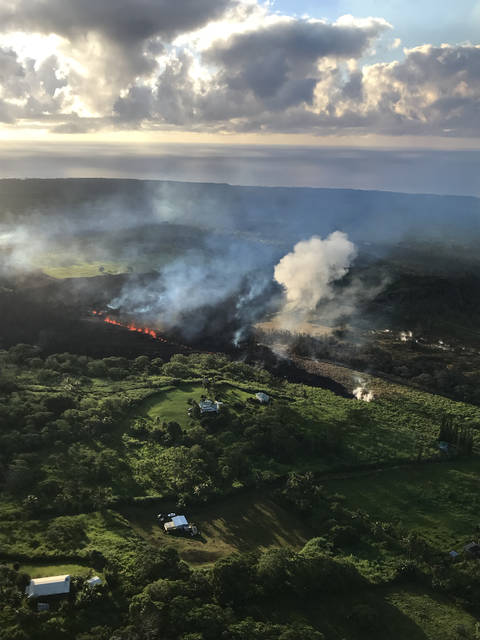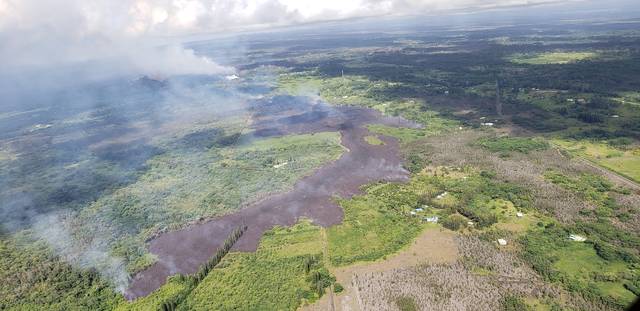HILO — As lava continued to flow from a fissure in Lanipuna Gardens late Monday, officials were considering contingencies if the lava cuts off a major highway.
Lava from the 17th fissure to open in Puna has flowed over a mile in a northeasterly direction at speeds up to more than 100 yards per hour. The flow’s direction brings it close to Highway 132, but also puts it on an eventual intersection with Highway 137.
County managing director Wil Okabe on Monday said the intersection with Highway 137 is the greater concern at present.
“(Highway) 132, right now, is not in imminent danger,” Okabe said, explaining that the lava is running largely parallel to Highway 132 as it flows toward the ocean.
More likely, and more worrisome, is the possibility of lava crossing Highway 137. Okabe said county and state officials are monitoring the lava every day to determine the best course of action.
Should the lava reach Highway 137, it will sever the last route for lower Puna residents to leave the area. A section of Highway 130, the only other major road servicing lower Puna, was closed last week after several cracks opened in the surface.
“There’s a steam vent on the road that’s making it impassable,” said Police Capt. Samuel Jelsma, Puna district commander. “It goes up and down. The other day, it was steaming very heavily. It’s just past Malama (Street), the second entrance to Leilani (Estates). If they live along the road…we will allow them in to get to their homes.”
The state Department of Transportation issued a statement Monday announcing the department’s intention to reopen Highway 130.
According to the statement, metal plates will be placed over the cracks on Highway 130, which are venting sulfur dioxide, but not lava. Electronic monitors at the site will measure heat and gas levels, while Department of Transportation and county employees will conduct physical surveillance.
Hawaii County spokesperson Janet Snyder said the DOT also has considered the construction of a temporary bridge over the affected area of Highway 130 or any future affected areas of Highway 137.
Other possibilities could include reopening Chain of Craters Road or Railroad Avenue.
Chain of Craters Road, which winds through Hawaii Volcanoes National Park, is currently blocked by past lava flows, but Okabe said bulldozing through the hardened lava or building ramps over it could be an option.
As for Railroad Avenue, Okabe said the road is currently “passable,” but reopening the road would require cooperation from W. H. Shipman Ltd., which owns portions of the road.
In the meantime, only local traffic is allowed on Highway 132 between Kaululaau Road and Highway 137, due to the proximity of the lava.
“There’s a little finger going out; there’s a ridge, and (Hawaiian Volcano Observatory) is thinking it’s not going to hit 132,” Okabe said. “But if it does hit 132, what’s going to happen is that we have (Government) Beach Road available.”
Government Beach Road goes between the intersection of Highways 132 and 137 in Kapoho and Kahakai Boulevard in Hawaiian Beaches. Okabe said the road “is only for local traffic right now”
“It’s not for the sightseers,” Okabe said. “It’s only for the local people that live down there right now. And that’s it.”
“We just want to make sure that the residents that live beyond our checkpoints in the area that we’re screening need to be pretty much ready to move on short notice,” Jelsma said. “It’s a tenuous situation and a developing situation. There’s a potential for that lava flow to impact their accessibility to their residences down in that area. They should be making plans now, should the situation continue to develop. With the present course, it looks like, if it continues, it will be cutting off one of the access routes (Highway 137) in the near future.”
Fissure 17 is by far the most active of the 18 fissures that have opened so far. Since lava began erupting May 3 in lower Puna, 37 structures have been destroyed, 26 of which were homes.
The flow of lava has slowed “quite a bit” since it began Sunday, HVO spokesperson Janet Babb said Monday. However, she said, it has traveled more than a mile and is only about one mile away from Highway 137.
Moreso than the lava, however, volcanic ash and toxic gases pose threats to the health of lower Puna residents. Significant quantities of sulfur dioxide from the Puna vents and ash from the crater have blown across the southeastern and southern sides of the island.
Alvin Bronstein, chief of the Hawaii Department of Health’s Emergency Medical Services and Injury Prevention System Branch, said Monday the best way for residents to avoid adverse effects from sulfur dioxide is simply to leave the affected area.
While some cartridge masks are able to filter sulfur dioxide from the air, their use is specialized to the point that Bronstein said he does not recommend their use by the general public.
Bronstein also discounted other makeshift air-filtration methods, such as breathing through a cloth soaked with baking soda, saying that, as a physician, he cannot recommend such practices as they have not been proven to have any effect.
However, Bronstein said basic store-bought dust masks can provide protection from volcanic ash.
Ash has periodically risen from Kilauea summit, located inside Hawaii Volcanoes National Park, as rocks frequently fall into Halema‘uma‘u crater, said Steve Brantley, deputy scientist-in-charge at HVO. Among the ash plumes, he said, are small fragments of solidified magma, which indicate several things: that the volcano’s conduit remains open and unplugged by rocks and that the fragments show no signs of interaction with water.
The possibility of a violent steam explosion or explosions remains, however. Brantley said rocks may fall and plug the conduit, building up steam pressure after groundwater seeps into the shaft, eventually causing an explosion that propels rocks miles away.
Such an explosion is nearly impossible to predict, Babb said. Most of Hawaii Volcanoes National Park therefore remains closed to the public, save for the Kahuku unit on the southern slopes of Mauna Loa.
Park spokesperson Jessica Ferracane said the national park would consider expanding the number of days the Kahuku unit will open each week. The unit is currently only open Fridays, Saturdays and Sundays.
HVO will continue to monitor emissions from the summit, said USGS geophysicist Kyle Anderson. Such emissions are the only way to determine whether the receding lava lake has reached a point lower than the water table. Anderson said the precise level of the water table at the conduit is unknown, and the lava lake is no longer visible from the surface.
While the flow of lava from the newest fissures in Puna has drained lava from the East Rift Zone and the Kilauea lava lake, Babb said the lava from fissure 16 has signs of coming from newer magma than lava from previous fissures — lava from previous fissures is believed to have remained in the East Rift Zone since the 1955 lava intrusion, and possibly earlier. Newer lava tends to be hotter and can therefore create faster, more voluminous lava flows.
Although the lava flows from the most recent fissures have avoided the Puna Geothermal Venture power plant north of Lanipuna Gardens, final preparations will be made to secure the facility over the next several weeks, said Tom Travis, head of the Hawaii Emergency Management Agency.
Some 60,000 gallons of highly flammable pentane was removed from the site last week, but several wells remain open, Travis said, with three currently active. Cold water will be injected into the three active wells before plugs will be installed on each, effectively “killing” the wells.
Travis said other wells will be addressed similarly after the active wells are killed.
Meanwhile, nearly 500 evacuees are being housed at the Pahoa Community Center, which serves as a Red Cross shelter. Another shelter, at Keaau Community Center, houses approximately 25 evacuees, Snyder said.
Red Cross is looking for volunteers to staff the shelters. To volunteer, please go to www.redcross.org and complete an online volunteer application. For questions, call (808) 739-8123.
A Salvation Army distribution center will open today near the Pahoa community pool to process items for evacuees. The Salvation Army also is seeking volunteers to work at the distribution center to help sort items.
All food donations, including bottled water, should be directed to the Hawaii Food Basket. Clothing donations should be made at any of the three Salvation Army locations on the island.
An updated map of fissures and lava flows can be found at https://www.hawaiicounty.gov/2018-lava-map.
Email Michael Brestovansky at mbrestovansky@hawaiitribune-herald.com
Email John Burnett at jburnett@hawaiitribune-herald.com










I thought they repaired Chain of Craters Rd a few years ago during the last Lava episode for evacuation purposes.
National park is closed at the moment and that road was cut off by recent flows too. Don’t listen to Wil Okabe, he couldn’t find his a*% with a GPS and all he does is repeat what others say. My guess is they will wait until the roads are completely blocked and impassable before doing anything. This is the Harry Kim style, do nothing until its too late.
As for Railroad Avenue, Okabe said the road is currently “passable,” but reopening the road would require cooperation from W. H. Shipman Ltd., which owns portions of the road.
I am sure some astronomical dollar amount could be reached to use the road in an time of emergency. Its not like our government has not over paid for something before!